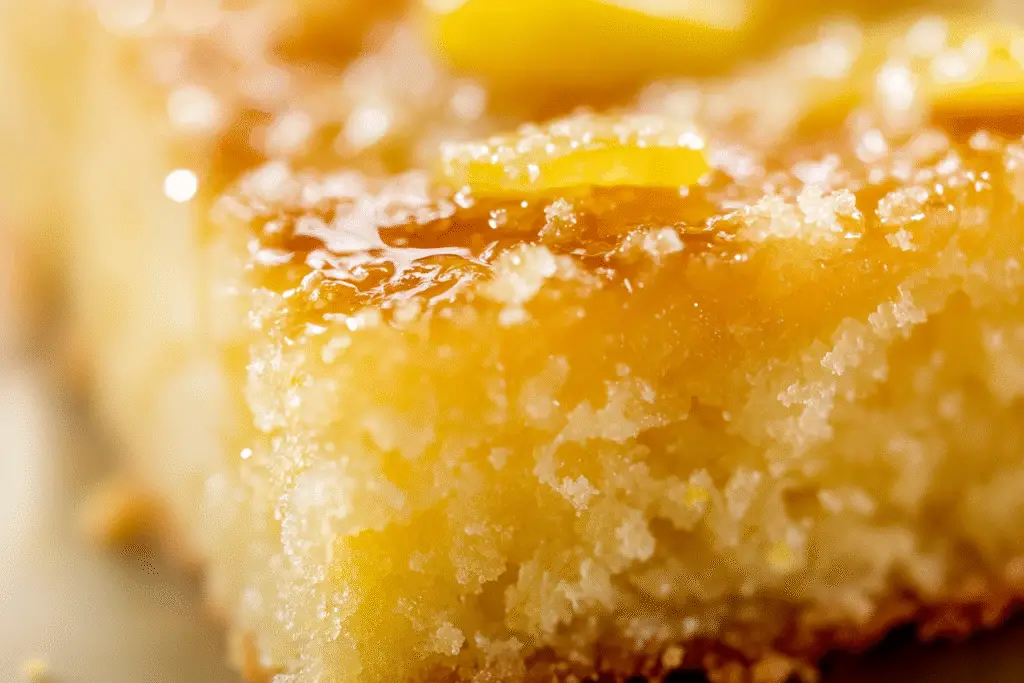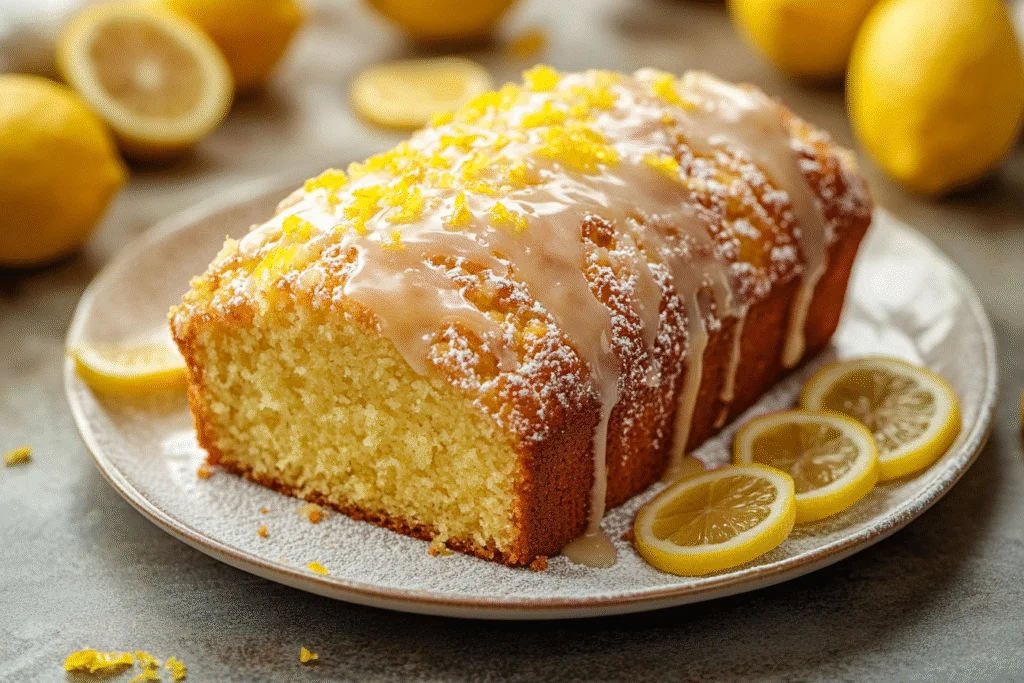The Classic Comfort of Lemon Drizzle Cake
Few cakes have achieved national treasure status quite like the Lemon Drizzle Cake. A staple of British baking, this beloved loaf is celebrated for its buttery crumb, bright citrus flavour, and irresistibly sticky lemon glaze that soaks into the sponge, leaving it moist and zingy with every bite.
Simple in form but bold in flavour, lemon drizzle cake strikes a beautiful balance between sweet and tart. It’s the kind of bake that feels just right at any time—whether with a cup of tea in the afternoon, at a garden party, or as a casual weekend treat. It’s also an excellent option for beginner bakers, with a straightforward method and ingredients you likely already have at home.
This recipe captures everything that makes a classic lemon drizzle cake great: a fluffy, tender crumb, intense lemon aroma from zest and juice, and a sugar glaze that crystallises ever so slightly on top, creating that signature crackly finish.

The Key to Perfect Lemon Drizzle Cake
Butter or Oil?
- Unsalted Butter is traditional, creating a rich, buttery flavour and stable structure. Beat it well with sugar for a light, airy texture.
- Oil can be used for a moister, denser cake, but it will lack that classic buttery taste.
Sugar:
- Caster Sugar (superfine sugar) is ideal for both the cake and the drizzle, as it dissolves quickly and creates a light texture.
- For the drizzle, granulated sugar adds a slight crunch when left un-dissolved on the surface, which some bakers prefer.
Lemons:
- Fresh Lemons Only! You’ll use both the zest and juice for maximum citrus punch. One large lemon yields about 2–3 tablespoons of juice and 1 tablespoon of zest.

Recommended Equipment
- Loaf Tin (2 lb / 900g size): The classic shape for lemon drizzle.
- Microplane or Zester: For finely grating lemon zest without bitter pith.
- Electric Mixer or Wooden Spoon: To cream butter and sugar until light and fluffy.
- Skewer or Toothpick: To poke holes into the cake so the drizzle can soak in.
- Measuring Jug: To easily pour the drizzle over the cake.
Common Mistakes and How to Avoid Them
1. Overmixing the Batter
Overmixing can lead to a tough, rubbery texture. Once you add the flour, mix just until combined.
2. Not Creaming the Butter Properly
Cream the butter and sugar well to incorporate air—this is what gives the cake its lift and fluffiness.
3. Under-Baking
A soggy middle means the cake wasn’t baked long enough. Always test with a skewer—it should come out clean.
4. Pouring the Drizzle on Cold Cake
The cake should still be warm when you add the drizzle so it absorbs properly.
Ingredient Swaps and Dietary Variations
- Dairy-Free: Use dairy-free butter and milk alternatives such as almond or oat milk.
- Gluten-Free: Substitute plain flour with a 1:1 gluten-free blend.
- Vegan: Use plant-based butter, a dairy-free milk, and a flax egg (1 tbsp flaxseed + 3 tbsp water) in place of egg. The texture will be slightly different but still delicious.
Make-Ahead Tips & Freezing
- Bake in Advance: Cake keeps well for 3–4 days at room temperature in an airtight tin.
- Freezing: Freeze the whole cake or slices (without drizzle for best texture) wrapped tightly in cling film and foil. Thaw and drizzle fresh lemon glaze before serving.
- Drizzle Ahead: You can make the glaze up to 2 days in advance and refrigerate.
Extra Touches and Serving Ideas
- Add Crunch: Sprinkle a little granulated sugar on top of the drizzle for texture.
- Glaze Instead of Drizzle: Mix icing sugar with lemon juice for a thicker, decorative glaze.
- Double the Lemon: Add lemon extract or more zest for a sharper citrus hit.
- With Berries: Serve with fresh blueberries, raspberries, or a compote for added colour and flavour.
Lemon Drizzle Cake Recipe
Ingredients
For the Cake:
- 225 g (1 cup) unsalted butter, softened
- 225 g (1 cup) caster sugar
- 4 large eggs
- 225 g (1 ¾ cups) self-raising flour
- Zest of 2 lemons
- 2 tbsp milk
For the Drizzle:
- Juice of 2 lemons
- 100 g (½ cup) caster sugar or granulated sugar
Instructions
Step 1: Preheat and Prep
- Preheat your oven to 180°C (160°C fan) / 350°F.
- Grease and line a 2 lb loaf tin with baking paper.
Step 2: Make the Batter
- In a large bowl, cream the butter and sugar together with an electric mixer (or wooden spoon) until pale and fluffy—about 2–3 minutes.
- Beat in the eggs one at a time, mixing well between each addition.
- Fold in the flour gently, then stir in the lemon zest and milk until smooth and combined.
Step 3: Bake the Cake
- Spoon the batter into the prepared tin and smooth the top.
- Bake for 45–50 minutes, or until a skewer inserted into the centre comes out clean.
Step 4: Make the Drizzle
- While the cake is baking, mix the lemon juice and sugar in a small jug. Stir until the sugar dissolves (or leave a few grains for texture if preferred).
Step 5: Drizzle and Cool
- As soon as the cake is out of the oven, poke holes all over the top with a skewer.
- Slowly pour over the lemon drizzle, letting it soak into the warm sponge.
- Leave to cool in the tin completely before removing and slicing.
Storage and Reheating
- Room Temperature: Keeps for 3–4 days in an airtight container.
- Freezer: Wrap well and freeze for up to 2 months. Thaw at room temperature.
- Microwave: Not ideal—reheating can dry it out. Instead, serve at room temp.
Troubleshooting Tips
- Cake Too Dense: Make sure to cream butter and sugar properly, and don’t overmix after adding flour.
- Cake Cracked on Top: Normal for loaf cakes, but you can reduce this by baking on a slightly lower temperature.
- Cake Soggy in the Middle: Needs longer baking. Cover with foil if browning too quickly on top.
Variations: Classic vs. Modern Takes
- Classic: Traditional loaf cake with sugar-lemon drizzle.
- With Glaze: Add a thick icing sugar and lemon juice glaze once the cake is cool.
- Upside-Down Lemon Drizzle: Add thin slices of lemon to the bottom of the tin for a decorative finish.
You can also infuse with rosemary, thyme, or even lavender for a more floral, herby variation.
Serving Suggestions
- With Tea: A classic pairing—English Breakfast, Earl Grey, or chamomile.
- With Berries and Cream: A simple but elegant way to dress it up.
- With Greek Yogurt: The tartness pairs wonderfully with the sweet, zesty sponge.
Lemon drizzle cake is the very definition of a classic bake: dependable, delicious, and effortlessly elegant. Whether for a casual afternoon tea or a celebratory spread, it’s a timeless treat that always impresses.
